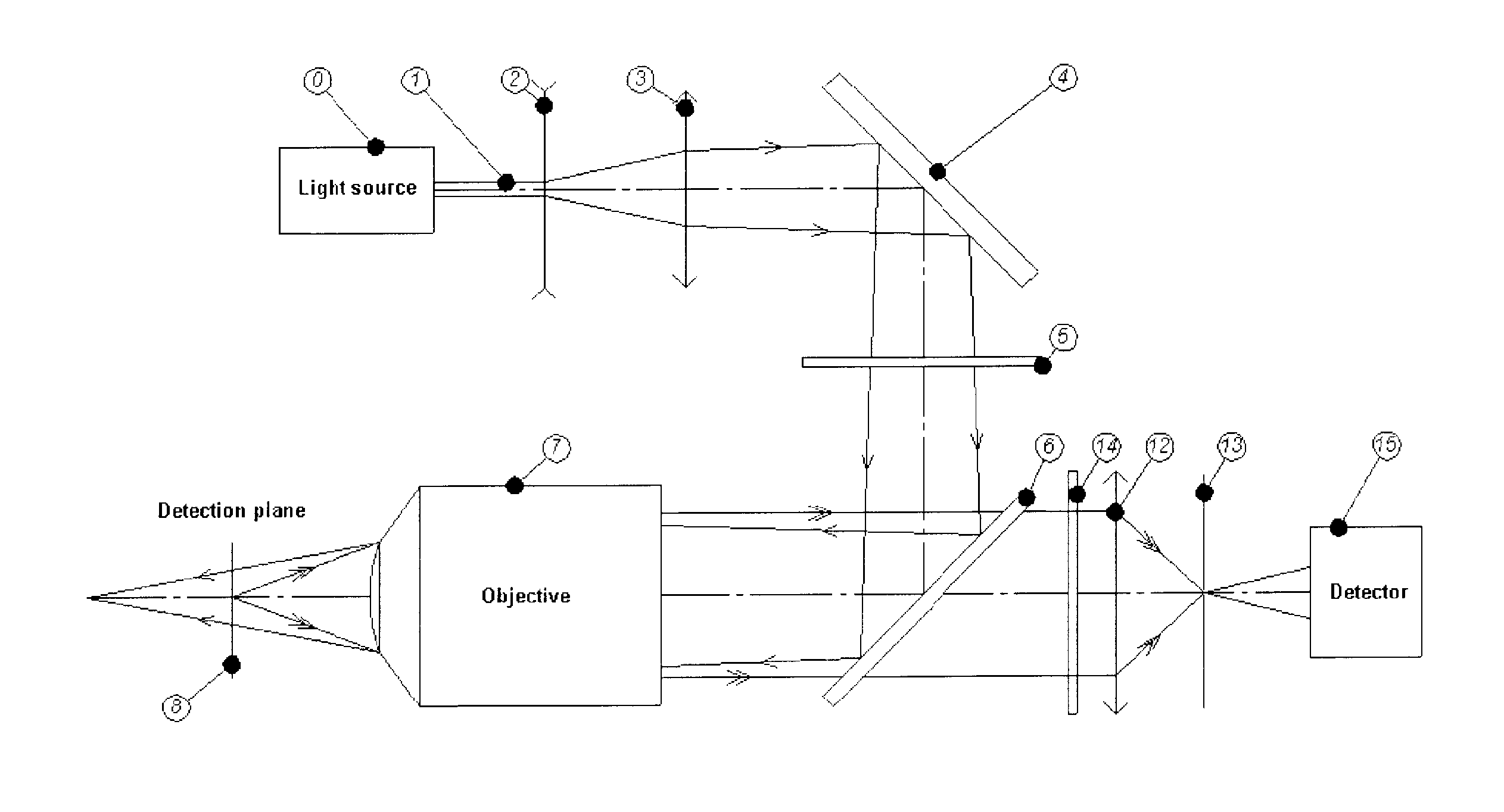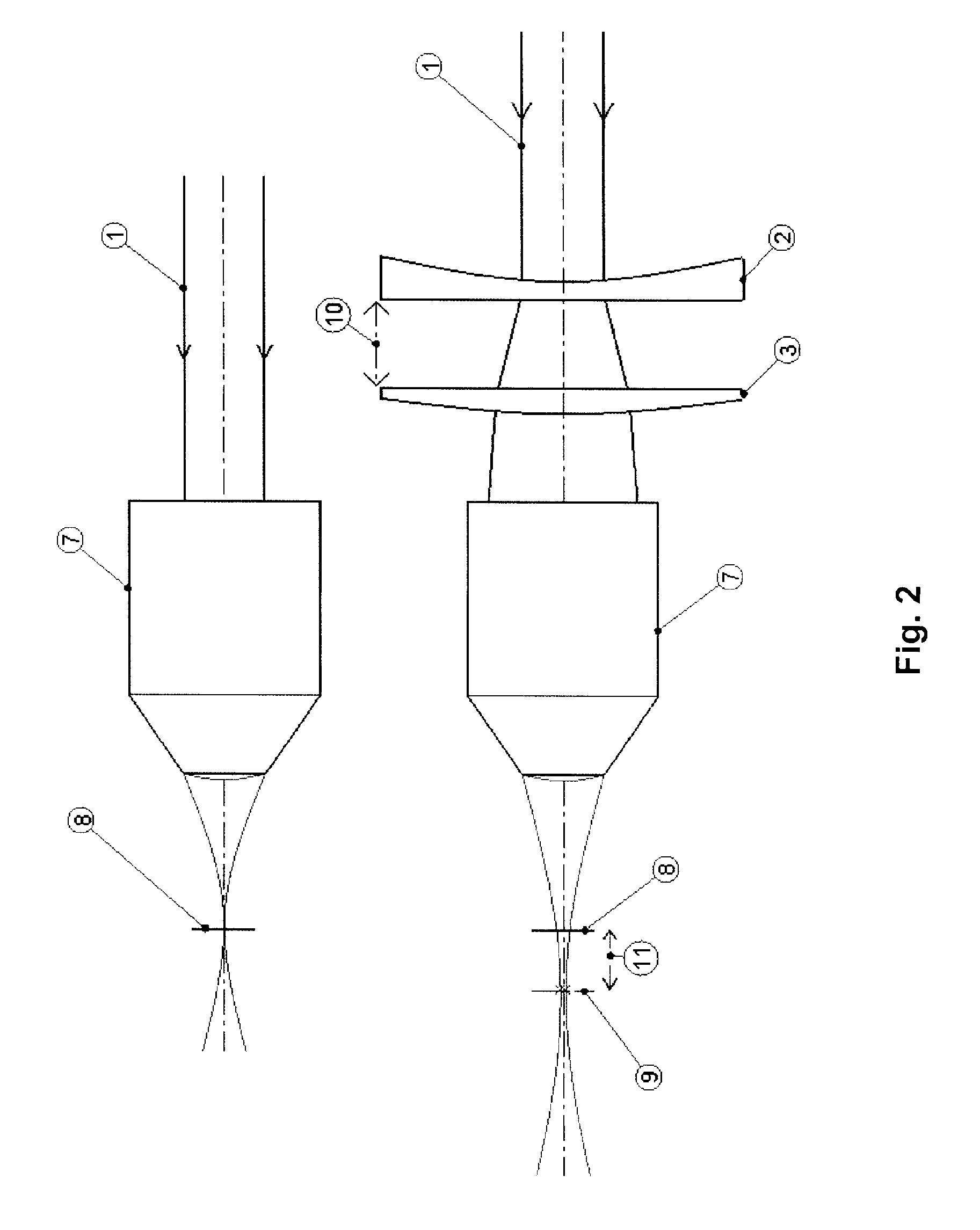Method and apparatus for detecting fluorescence emitted by particle-bound fluorophores confined by particle traps
- Summary
- Abstract
- Description
- Claims
- Application Information
AI Technical Summary
Benefits of technology
Problems solved by technology
Method used
Image
Examples
example 1
[0098]A solid state laser diode emitting at 405 nm (PointSource, iFLEX2000) used as a light source 0 is coupled to a pigtailed single mode optical fiber equipped with a collimator at the fiber end (PointSource, KineFLEX) that produces a 1 mm diameter (at 1 / e2) diffraction limited beam 1 with a divergence angle of less than 0.1 mrad.
[0099]The divergence of the beam is induced by means of a pair of lenses 2, 3 (Thorlabs, f=−30 mm, LC4252 and f=75 mm, LA4725) and controlled through the spacing of the lenses. For the present demonstration, lenses were separated by 41 mm. According to FIG. 4, a lens pair separation 10 of 41 mm generates a 75 μm beam footprint (radius measured at 1 / e2) at the focal plane 8 thus enabling the whole μ-EMT illumination. With such parameters, 70% of beam energy is contained within the μ-EMT diameter.
[0100]The μ-EMT consist of 75-μm diameter planar micron-scale gold conductors supported on SiO2 / Si wafers, a design previously described by Dubus et al.
[0101]The l...
example 2
[0108]Another specific example of components usable for the selective detection of minute amounts of target genomic DNA from gram positive bacteria-containing samples, as in the illustrated embodiments of the invention includes:
[0109]A microfluidic system 20 having a combination of two different particle traps, namely a μ-EMT 22 and a weir 36 has been used for this series of experiments. The PDMS microfluidic channels 38 are 100 microns wide, 20 microns high, and the weir leaves a shallow gap in the microfluidic channel of 2 microns in height, enabling to trap small paramagnetic particles of 2.8 microns diameter while allowing the sample solution to flow through the weir.
[0110]Samples of initially approx. 500 particles grafted with probe DNA (=ssDNA sequence complementary to target ssDNA sequence) and a fluorescent biosensor were prepared and pumped into the microfluidic system through sample inlet 32 using a syringe pump 40. Particles were trapped at the weir while the solution was...
example 3
[0112]Another specific example of components usable for the selective detection of minute amounts of target genomic DNA from an endospore-forming bacteria-containing samples, as in the illustrated embodiments of the invention includes:
[0113]A microfluidic system, sample preparation, sample handling, data acquisition and data analysis procedures as described in Example 2, with the exception that only one replica per sample (Specific Sequence, Non-specific Sequence and Reference) was tested.
[0114]These results, shown in FIG. 20, highlight the very high sensitivity (i.e. approx 500 genomic DNA copies detected in the particle trap) and selectivity of such an approach (good contrast with respect to the Non-specific Sequence and Reference samples). It also shows the possibility to detect, with comparable performance, different genomic DNA sequences originating from different samples. It finally shows the potential to perform rapid tests on limited sample volumes / amounts with reliable resu...
PUM
 Login to View More
Login to View More Abstract
Description
Claims
Application Information
 Login to View More
Login to View More - R&D
- Intellectual Property
- Life Sciences
- Materials
- Tech Scout
- Unparalleled Data Quality
- Higher Quality Content
- 60% Fewer Hallucinations
Browse by: Latest US Patents, China's latest patents, Technical Efficacy Thesaurus, Application Domain, Technology Topic, Popular Technical Reports.
© 2025 PatSnap. All rights reserved.Legal|Privacy policy|Modern Slavery Act Transparency Statement|Sitemap|About US| Contact US: help@patsnap.com



